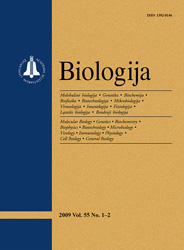Biologija / Biology
 ISSN 1392-0146 ISSN 2029-0578 (online) |
2007 m. Nr. 2 Potential reproduction and real seed
productivity of Vicia villosa L.
Seed number is one of the most important aspects of reproductive success in annual plants. Seeds play a vital role in agricultural development for both food and forage crops.
The aim of the present work was to investigate the potential reproduction and real seed productivity of V. villosa. The experimental object was wild V. villosa cenopopulations from different places of the country. The seeds were sown and investigated in the collection of the LUA Experimental Station (Central Lithuania, medium loam, pH 7) in 2000–2006. Phenological observations of vegetation stages were performed. The morphological plant assessment was based on measuring stem height, the number of inflorescences and flowers, the number of pods, seed number per pod and plant, the fresh weight of stems, leaves and flowers per plant. Diseases and pest activity were determined. Analysis of the material was done at the Laboratory of Crop Production Department of the LUA. The experimental findings indicate that variable weather conditions affected the phenological, morphological and productivity parameters of V. villosa as well as the spread of fungal diseases and pests. The process and end of the growing season were greatly influenced by drought and diseases. Stresses at different times had different effects on leaf mass which is potentially able to photosynthesize and to provide energy for plant growth, flowering and fruiting. In V. villosa, water and temperature stress, leaf area loss due to fungal diseases and herbivory result in a reduced mass of a plant as well as a less number of flowers and pods produced per plant. A distinct linear correlation was determined between the mass of foliage and flower mass, as well as between flower mass and seed number per plant. V. villosa featured a great potential reproduction, but a low real productivity. The most stable reproductive features were the number of seed per plant, pod formation frequency, matured seed ratio per plant. Keywords: reproduction, seed productivity, stress, fungal diseases, Vicia villosa |
Issues:
2011 - Vol.57 No. 1, No. 2, No. 3 2010 - Vol.56 No. 1-4 2009 - Vol.55 No. 1-2, No. 3-4 2008 - Vol.54 No. 1, No. 2, No. 3, No. 4 2007 - Vol.53 No. 1, No. 2, No. 3, No. 4 2006 No. 1, No. 2, No. 3, No. 4 2005 No. 1, No. 2, No. 3, No. 4 2004 No. 1, No. 2, No. 3, No. 4 2003 No. 1, No. 2, No. 3, No. 4 2002 No. 1, No. 2, No. 3, No. 4 2001 No. 1, No. 2, No. 3, No. 4 |